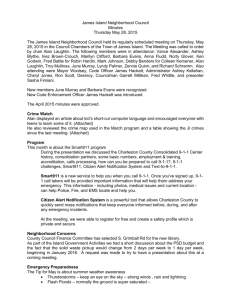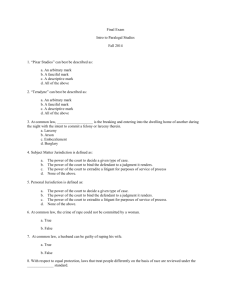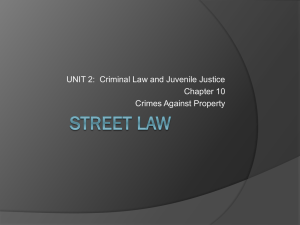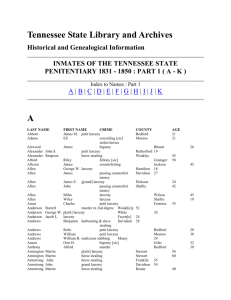CRIMINAL LAW AND PROCEDURE
advertisement
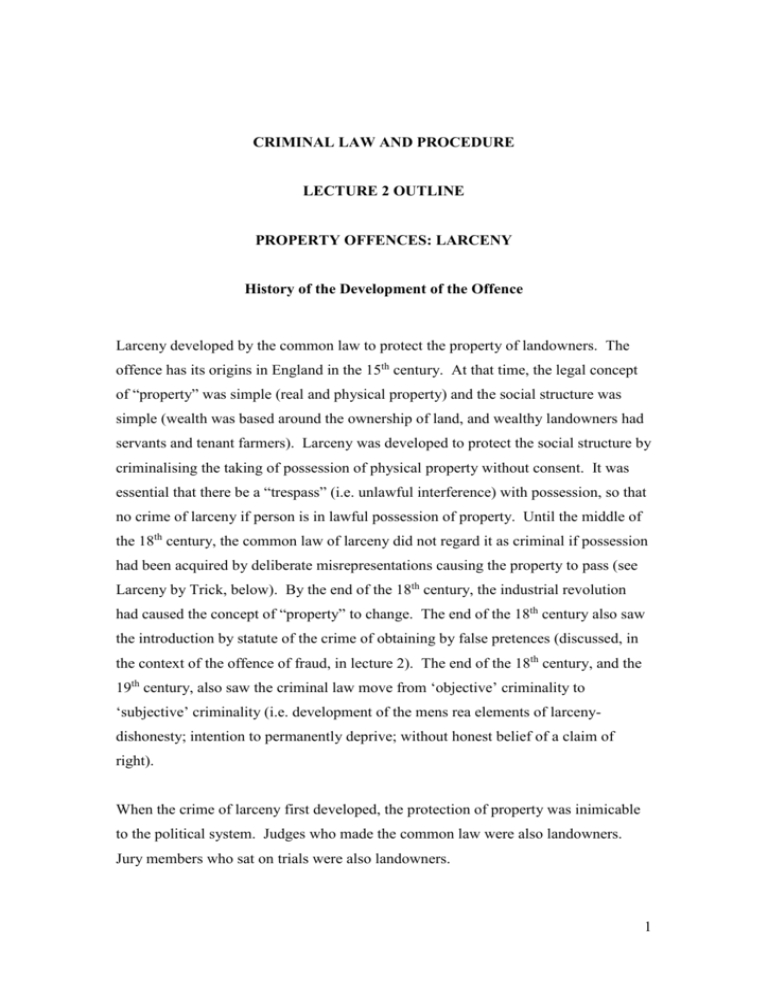
CRIMINAL LAW AND PROCEDURE LECTURE 2 OUTLINE PROPERTY OFFENCES: LARCENY History of the Development of the Offence Larceny developed by the common law to protect the property of landowners. The offence has its origins in England in the 15th century. At that time, the legal concept of “property” was simple (real and physical property) and the social structure was simple (wealth was based around the ownership of land, and wealthy landowners had servants and tenant farmers). Larceny was developed to protect the social structure by criminalising the taking of possession of physical property without consent. It was essential that there be a “trespass” (i.e. unlawful interference) with possession, so that no crime of larceny if person is in lawful possession of property. Until the middle of the 18th century, the common law of larceny did not regard it as criminal if possession had been acquired by deliberate misrepresentations causing the property to pass (see Larceny by Trick, below). By the end of the 18th century, the industrial revolution had caused the concept of “property” to change. The end of the 18th century also saw the introduction by statute of the crime of obtaining by false pretences (discussed, in the context of the offence of fraud, in lecture 2). The end of the 18th century, and the 19th century, also saw the criminal law move from ‘objective’ criminality to ‘subjective’ criminality (i.e. development of the mens rea elements of larcenydishonesty; intention to permanently deprive; without honest belief of a claim of right). When the crime of larceny first developed, the protection of property was inimicable to the political system. Judges who made the common law were also landowners. Jury members who sat on trials were also landowners. 1 In England, “simple larceny” was distinguished from “grand larceny” where the value of the property was worth more than one shilling. Grand larceny carried the death penalty. Courts developed elaborate technical distinctions and defences to larceny to avoid having to impose the death penalty. For a discussion of the historical context of the evolution of the law of larceny, see G.P. Fletcher, “The Metamorphosis of Larceny” (1976) 89(3) Harvard Law Review 496; D Hay, ‘Property, Authority and the Criminal Law’ D.Hay et al ‘Albion’s Fatal Tree’ Penguin 1975 (both extracted in Rush and Yeo, Criminal Law Sourcebook). Due to the technical distinctions, particularly over the issue of whether or not something is “property capable of being stolen” common law (and statute in NSW) developed a “patchwork quilt” of other offences. E.g. Larceny by a Bailee (Section 125 of the Crimes Act) Stealing cattle or killing cattle with intent to steal (Section 126) Stealing dogs (Section 132) Stealing court records (Section 138) Stealing metal, glass, wood etc fixed to house or land (Section 139) Stealing trees, etc., in pleasure grounds, etc. (Section 140) Stealing goods in process of manufacture (Section 150) Stealing from ship in distress or wrecked (Section 153) 2 Note that the offence of Car Stealing under Section 154AA was repealed on 1 September 2006, but Stealing a Motor Vehicle or Vessel remains an offence under Section 154F. Further, it is an offence (and deemed larceny) to take a conveyance (the definition of which includes cars, motorbikes and trucks) without the consent of the owner or person in lawful possession under Section 154A; and ‘carjacking’ (i.e. taking a motor vehicle with assault) is an offence under Section 154C. Since February 2009, the Crimes Act has also contained offences dealing with the issue of ‘car rebirthing’ (Sections 154G-154J) Codification of Property Offences Theft Act (1968) UK abolished common law larceny and replaced it with a comprehensive code dealing with property offences. In 1995, Model Criminal Code Committee recommended all Australian states adopt the Theft Act model, and replace over 150 offences dealing with fraud, theft and larceny with a code of 20 offences. Theft Act model adopted in Victoria in 1985 and South Australia in 2002. It has not been adopted in NSW in respect of larceny offences, but a similar model has been adopted in adopted in NSW on 22 February 2010 in respect of fraud offences (discussed in Lecture 3). Penalties for Larceny Larceny is an indictable offence (maximum penalty 5 years imprisonment under Section 117, but if property of small value, can be dealt with summarily before the Local Court). 3 Basic Larceny Definition Section 117 of Crimes Act does not define the elements of larceny. Such elements derive from the common law. Elements of Larceny “At common law, larceny is committed by a person who, without the consent of the owner, fraudulently and without a claim of right made in good faith, takes and carries away anything capable of being stolen with intent, at the time of such taking, permanently to deprive the owner thereof” (Wilson and Dawson JJ in Illich v R (1987) 162 CLR 110 at 123) Actus Reus (Physical) Elements Property Capable of Being Stolen; Taken and carried away (Asportation-moved; Appropriation-physical interference) Without consent of owner of the property Mens Rea (Mental) Elements Dishonesty (see Section 4B of Crimes Act) Intention to permanently deprive 4 No honest belief of a claim of right over the property (although the breadth of the concept of honest belief of claim of right is controversial-see discussion below and in following lectures on property offences) The above actus reus and mens rea elements must be legally contemporaneous (i.e. the mens rea elements must occur at the time the property is taken). However, this can create difficulties when the taker of the property was initially unaware that the property had been acquired, but subsequently decided (dishonestly) to keep the property. The doctrine of continuing trespass deals with this issue. ACTUS REUS Property which is “already out of the possession of the owner by reason of its having been previously stolen” can be stolen, and the offender convicted of larceny or other property offences-Section 94AA Property defined in Section 4 as including: “every description of real and personal property; money, valuable securities, debts, and legacies; and all deeds and instruments relating to the title or right to any property, or giving a right to recover or receive any money or goods; and includes, not only property originally in the possession or under control of any person, but also any property into or for which the same may have been converted or exchanged, and everything acquired by such conversion or exchange, whether immediately or otherwise” Types of Property Which Are Capable of Being Stolen Corpses. Kelly (1998) Illegal Property Anic (1993) 5 Types of Property Which Cannot be Stolen Cannot steal property which you have a lawful right to possess, nor which was given by consent: Money in joint bank account to which the Defendant had a legal right to withdraw money from the bank: Croton (1967) Asportation/Appropriation Asportation is the physical movement of property. Slight physical movement of property is sufficient-moving property from one part of a truck to another Wallis v Lane (1964) Appropriation is a physical act (or acts) which “involves an element of adverse interference with or usurpation of the right of the owner”, such as taking goods off shelves in a grocery store and changing the labels for a lower price Morris (1984) Without Consent of the Owner In certain circumstances, owners of goods allow (licence) persons to physically pick up and inspect goods. However, if the person exceeds the licence, they have asported or appropriated the goods without consent: Kolosque v Miyazaki (1995) per Dowd J: “The consent implied is that the goods may be taken from the display, for fitting where appropriate, or for inspection, or to cash register either directly or indirectly for the purpose of purchase. If goods are taken with a view of depriving the owner of those goods…this is clearly outside the terms of the consent…It follows, therefore that the licence granted by an owner to remove goods is broken if there is any action inconsistent with the licence allowing clothing to be removed for a fitting or to take goods to a cash register for purchase or lay-by…A person who conceals goods by placing them in a 6 pocket or concealing them in a bag, as against just placing them in a bag or trolley, can be adduced as evidence of an action inconsistent with the terms of the licence”. Scope of the licence agreement-Kennison v Daire (1986), where D withdrew $200.00 from an “off line” ATM, despite knowing that he had closed the account from which the funds had been withdrawn (and, consequently, knowing that there were no funds in the account). Gibbs CJ, Mason, Wilson, Deane and Dawson JJ: “The machine could not give the bank’s consent in fact and there is no principle of law that requires it to be treated as though it were a person with authority to decide and consent. The proper inference to be drawn from the facts is that the bank consented to the withdrawal of up to $200.00 by a card holder who presented his card and supplied his personal identification number, only if the card holder had an account which was current”. However, need to distinguish between the offences of larceny and fraud (a separate offence). In fraud, property ostensibly passes by consent, but the consent was obtained because of deception. In larceny, property is physically taken or interfered with. Fraud is discussed in lecture 2. Defendant can still be convicted of larceny if property does not have an “owner”, but prosecution must state in the indictment or Court Attendance Notice that the owner of the property cannot be identified, and prove that the owner can’t be identified Ellis v Lawson (1987) MENS REA Intention to Deprive Owner Permanently 7 Section 118. Does it remove intention to permanently deprive? No. Foster (1967). Barwick C.J.“(Larceny)…involved an intention on the part of the applicant to assume ownership of the gun, to deprive Baker permanently of it, to deprive him of property in it. I use these three expressions, which are several ways of establishing the same essential element of larceny, namely the intention to appropriate the goods to himself. To intend to deprive the true owner permanently of the possession of the goods is one form of the requisite intention. An intention to deprive him of his property in the goods is another, that is, an intention to appropriate the goods as distinct from merely to assume possession of them. Section 118…does not deny the necessity for an intention in one of these forms to accompany the taking. It merely ensures that the consequence of forming or having that intention is not defeated by an intention eventually to restore the property to the true owner. This, if the intention is to deprive the true owner for a limited time, larceny is not made out. But if the intention of the taker is to exercise ownership of the goods, to deal with them as his own, an intention later to restore the property in the goods will not prevent the original taking being larcenous.” Subsequent intention to return property does not mean there is no intention to permanently deprive at the time of the taking, nor an intention to substitute different property of the same value Cockburn (1968) Intention to Permanently Deprive At the Time Property is Taken-The Doctrine of Continuing Trespass The doctrine of continuing trespass. When does the criminal intention arise? (i.e. when is the dishonesty; lack of belief of honest claim of right; and intention to permanently deprive legally contemporaneous with the physical taking of the property? 8 Riley (1853) Baron Parke: “The original taking was not lawful. The prisoner, being originally a trespasser, he continued as a trespasser all along…and, being a trespasser, the moment he took the lamb with a felonious intent, he became a thief”. Mingall v McCammon (1970) Bray CJ: “…if the original taking is a trespass, or it might be better to say, is tortious, the subsequent dishonest appropriation will be a larceny despite the general rule that the animus furandi must exist at the time of the taking…This has been said to be an anomalous rule and the invention of the judges in Riley…But I think now it is firmly established”. Dishonesty, Fraudulence, and the Issue of Honest Belief of Claim of Right Test of dishonesty is now defined in Section 4B of the Crimes Act (introduced on 22 February 2010): “4B (1) In this Act: dishonest means dishonest according to the standards of ordinary people and known by the defendant to be dishonest according to the standards of ordinary people” Section 4B effectively re-introduces the test in Ghosh (1982) and supersedes the High Court decisions of Peters (1998) and McLeod (2003) Honest belief in a claim of right negates the mens rea Lopatta (1983). Honest belief of claim of right means that the prosecution has not excluded beyond a reasonable doubt that the Defendant honestly believed he or she had a legal right to take possession of the property, or take its monetary equivalent. The test is subjective, not what a reasonable person would believe. However, there are limits to what is an honest belief of a claim of right over the property. The principles are summarised by Wood CJ at CL in Fuge (2001) 9 Special Types of Larceny Larceny by Mistake Larceny by Finding Larceny by Trick Larceny by Mistake Larceny by mistake deals with situations where property has been handed over, or taken, with apparent consent, but the person handing over (or transferring) the property was under a mistaken belief. The central issue is whether that mistaken belief vitiates (i.e. removes) consent? Bray CJ of South Australian Supreme Court in Potsik (1973)-For a mistake to vitiate consent it must be a “fundamental” mistake. High Court in Illich (1987) There are 3 types of fundamental mistake: i. Mistake as to the identity of the property; ii. Mistake as to the identity of the person to whom property transferred; iii. Mistake as to the amount/quantity of the property transferred (with the exception of money, as “it is an error to treat money in the form of cash in the same way as other goods…Upon any view, money passes into currency when it is negotiated and in this case, upon the applicant’s version of the facts, the transaction in which the money changed hands was both bona fide and for value. Thus the notes or coins ceased to be the subject of specific title as chattels and passed as currency…We do not 10 think that it is possible to say that only the correct amount of money was paid for valuable consideration and that the amount of the overpayment passed hands for no consideration and hence as mere chattels rather than as currency. Apart from the insuperable difficulty of identifying the notes or coins which constituted the overpayment, it is the transaction itself which characterises the payment. The transaction between the applicant and Brighton was bona fide and for value. The payment, which forms part of that transaction, was also of that character. It is not possible, in our view, to apportion the consideration of some of the chattels comprising the notes or coins transferred and not to others” per Wilson and Dawson JJ). However, in respect of mistakes involving the transfer of money into bank accounts by electronic means, and where either the Defendant took action to cause the money to be transferred knowing that he or she was not entitled to it, or it was obvious to the Defendant (and the Defendant knew) that they were not entitled to the money, the comments of the High Court regarding mistaken transfer of money have been distinguished: Shields v New South Wales Crime Commission (2007): “Whilst the principle stated in Illich is undoubted, I consider that little time needs to be given to the claimants’ submission on this point. In Kennison v Daire (1986) 160 CLR 129 the Court dealt with a situation very similar to which applies here. The contents of the Westpac investigation report included information that (Shields) knew the conditions of the operation of the ATR facility. He knew the collections area of the bank had placed a ban on his personal account responding to the ATR facility. He also knew that due to a ‘computer glitch’ that ban was not recognised by the ATR facility and he decided to take advantage of that failure and continued to draw on the account in an amount totalling almost $11 million…In my opinion, all the elements to constitute the offence of larceny have been alleged in one form or another… (per Beazley JA) 11 The remaining types of larceny covered in the course (larceny by finding and larceny by trick); and the property offences of fraud; breaking and entering and robbery are dealt with in Lecture 3. 12

